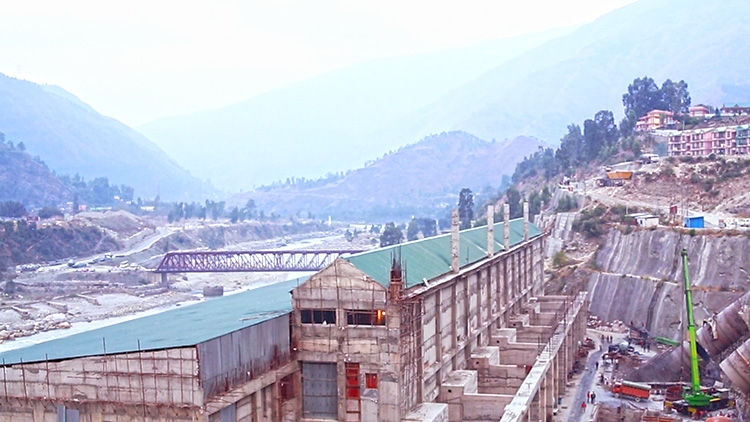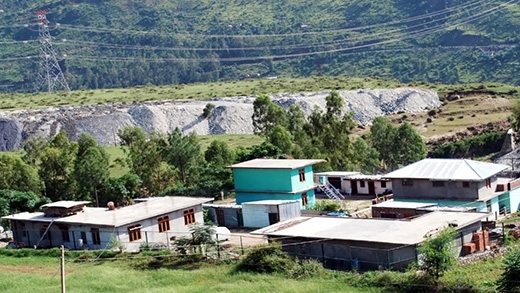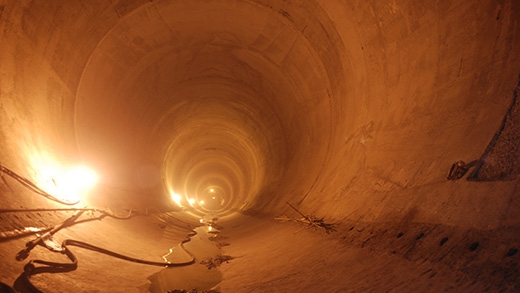Local Area Development
In an attempt to improve the quality of life for the people living in the general vicinity of the project, SJVNL had launched an intensive local area development scheme. Small community infrastructure facilities -- like footbridges and footpaths, street lighting and drinking water supply -- have been completed in various villages. The villagers have led the development exercise throughout. They have identified their needs, be it a new schoolroom, an irrigation channel, or a concrete mountain path, and the project has funded them. In many cases, the villagers have even taken part in the construction, with the project’s engineers guiding and helping them. Bayal village for instance, where the powerhouse is located, now has a new bus-stand, street-lighting, a post office, a new gram panchayat hall and a renovated village temple. SJVNL has so far spent Rs. 142 million for these infrastructure works. In addition, after the change in implementation arrangements for these local area development plans by the Government of Himachal Pradesh to the district administration, SJVNL is accordingly providing the funds to Local Area Development Authority (LADA) for various works identified by the communities. SJVNLhas to date made Rs 52.5 million available to district administration for developing small village infrastructure works in project-affected villages in the Shimla and Kullu districts. However, the implementation of LADA works has not progressed much since July 2012, and no fresh funds have been released by the state government since then. Both SJVNL and the World Bank have been and will continue to follow-up with the state government.
SJVNL had also undertaken to get two major drinking water works in the project-affected area implemented in collaboration with the state government. It has financed the installation of four borewells and seven handpumps at various locations in the project area so that villagers can draw water for their needs. It has also provided Rs 40 million towards a Rs 74.8 million-multi-panchayat drinking water scheme to be implemented by the the Irrigation and Public Health (IPH) Department.
Corporate Social Responsibility Works
As part of its corporate social responsibility activities too, SJVNL has spent Rs. 10.26 million in the Rampur project area during 2012-13 for various community development works such as playgrounds, renovation of temples and community halls, repair of school buildings, and scholarships to meritorious students in the project area. The company also plans to adopt the village of Bayal, where the powerhouse is located, as a model village and invest in its all-round development. In the coming years, the focus on CSR activities incudes training to women in vocational trades, health check-ups, scholarships and support to local schools to improve their infrastructure facilities.
Health facilities
SJVNL also runs a medical dispensary in Bayal; about 33,000 people from the project area have accessed the medical services there. The company is also financing a mobile health van since 2006 that does the rounds of the eight project-affected villages, taking basic healthcare to the people's doorstep. Till date more than 60,000 persons have availed of the services of this mobile health van.
Skill Development & Livelihood Opportunities
The construction of the large infrastructure project was also an opportunity for local people to find jobs. Some 344 local people found employment during the course of the project with the civil works contractors. One person from affected family has been provided regular employment in SJVNL. In addition, 11 local people have also got employed through HIMPESCO. SJVNL also made it a point to bring business to local entrepreneurs by hiring their vehicles or contracting their catering services etc. 59 families have benefited from hiring of vehicles for more than 3150 vehicle months.
Environmental Management
The implementation of the environment management plan, aimed at mitigating the environmental impacts of the project has is progressing as planned. Of a total outlay of Rs 233.8 million planned to be handed over to the state forest department for improving the Catchment Area in the Sutlej Basin, SJVNL has already deposited Rs. 214.77 million with the forest department which has informed SJVN that Rs. 155.26 million has been utilised upto March 2013. The forest department had asked SJVNL to work on improving the five nallahs in the basin and SJVN has completed that work.
Muck-dumping
SJVNL has set in place a robust system for ensuring that the debris being generated by tunnel excavation or other construction activity are safely dumped in designated sites that have strong retaining walls to stop the muck from slipping into the river. SJVNL environmental engineer vigorously monitors that their construction contractors stick to the agreed regime. In order to allow local communities and other stakeholders to also monitor the muck-dumping and to report if they find any unauthorized dumping of project debris in either the river or at non-designated sites, SJVNL has also displayed contact details of key project officials at public spots and all the four dumping sites.
Since tunneling work has been completed not much of muck is currently generated from the Project. Overall about 4.4 million cu.m of muc is generated in the project of which 2.55 cu m is disposed off at designated dump site and the remaining 40 percent has been recycled and used.
Restoration of Muck Dumping and Construction Sites
SJVN has piloted restoring two muck dumping sites by planting them over with an environment friendly geo-green blanket. This helps restore the sites with thick native vegetation that merges visually with the natural greenery in the area. SJVN is now scaling up this practice for all the muck dumping sites.
Onsite safety
The construction of tunnels is difficult and requires careful attention to safety rules and guidelines. In addition to equipping workers with standard safety gear, SJVNL has put stringent safety systems in place that include emergency response training; controlling and monitoring blasting for excavating tunnels; and technical measures for preventing accidental rock-falls. Safety audits are carried out periodically and any gaps founds are addressed by SJVNL and the contractors.


